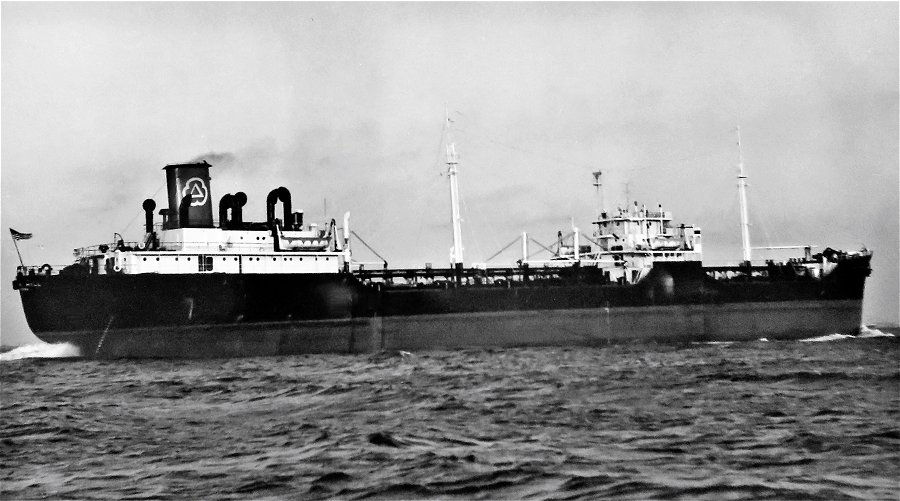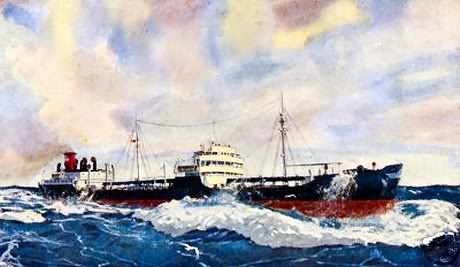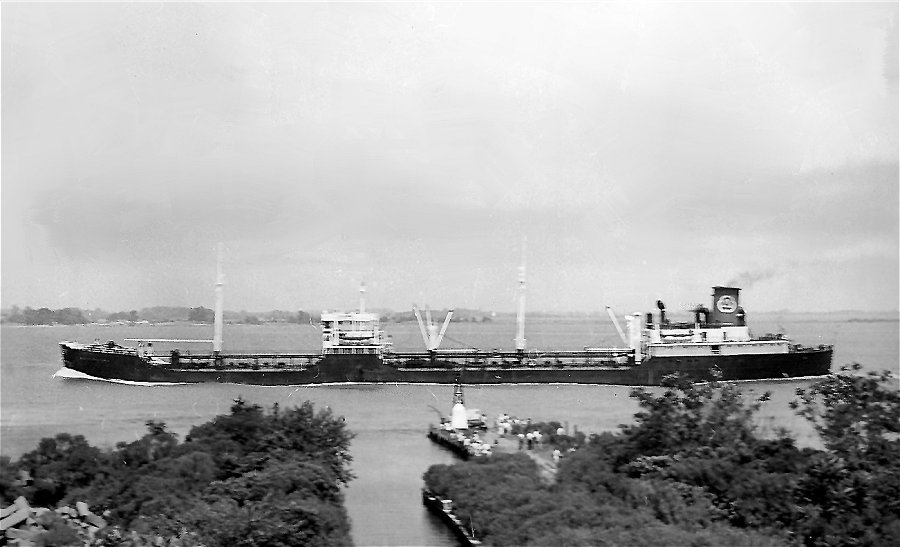Auke Visser's Famous T - Tankers Pages | home
Winter Hill
See also : Christening Leon Falk Jr., ex. "Winter Hill
See also : Leon Falk Jr., ex. Winter Hill
See also : On board photos "Leon Falk Jr., ex. "Winter Hill" ( Part-1 ) & On board photos "Leon Falk Jr., ex. "Winter Hill" ( Part-2 )
T2-SE-A1

( Photo Copyright W. Schell )

"Winter Hill".
"Winter Hill".
WINTER HILL, T2-SE-A1
History :
Built by Sun Shipbuilding & Dry Dock Co., Chester, Pennsylvania.
Yardnumber 477. UMSC No.2432. Official nr. 247576.
Keel laid 14-12-1944. Launched 02-04-1945. Completed 16-04-1945. Gr. 10297 t., Net. 6236 t., Dw. 16613 t. L.o.a. 159,57 m., Br. 20,78 m., Dr. 9,31 m. Engine: 2 steam turbines, manufactured by Westinghouse Electric & Manufacturing Company, Pittsburgh. 7240 B.h.p., 5401 kW. Speed 15 knots. 26 Tanks.
History:
WINTER HILL-1945 completed for United States War Shipping Administration, Philadelphia, USA.
WINTER HILL-1948 for Ships Inc., New York, USA, USA.
LEON FALK JR.-1960 for Skar-Ore Steamship Corporation, Hanna Mining Company, Cleveland, Ohio, USA.
Additional Reports:
Reported Leon Falk Jr. Lengthened, widened to bulk carrier for Great Lakes service, new midbody built by Schlieker Werft, Hamburg and fitted June 1961 by Bethlehem shipbuilding Company, Baltimore, Maryland.
New dimensions 222.6 / 216.0 x 22.9 m, 12501 grt / 24385 dwt.
Reported Leon Falk Jr. sold to shipbreakers in Spain. Arrived in tow from Quebec, Gijon 30 Sep. 1985 to be broken up. [ By Desguces Heme ]
|
Built by Sun Shipbuilding & Dry Dock Co., Chester, Pa as Hull #477. Launched on April 2, 1945 as the T2-SE-A1 tanker WINTER HILL for the U.S. Maritime Commission. Dimensions: 523' 6" loa x 68' 2" beam x 39' 2" depth; 10,537 GRT, 6,333 NRT. Powered by a 7,240 shp Westinghouse Electric steam turbo-electric engine and two Babcock & Wilcox oil-fired water tube boilers. The WINTER HILL was part of an emergency tanker building program during World War II in which 481 T2-SE-A1 tankers were completed by four U.S. shipyards. The T2s were built with nine cargo tanks with a total capacity of 141,200 bbl, three hydraulic cargo pumps of 2,000 gpm each, a cruising range of 12,600 miles, a mid-ship pilot house and accommodations for a crew of approximately 44. Built at a cost of nearly $3 million which included $850,000 of defense equipment, the construction time for these tankers averaged 82 days from keel laying to launching. The T2-SE-A1 nomenclature is defined as a Tanker (T), approximately 450 to 499 feet in water line length (2), steam powered turbo-electric engine (SE), and the first of the series (A1). Purchased by Cities Service Oil Co., New York, in 1949.
Sold to National Steel Corp., Cleveland in 1960. Converted to a Lake Bulk Freighter by removing the tanker mid-section and inserting a 503' bulk cargo mid-section constructed by Schlieker-Werft, Hamburg, Germany. The mid-section (Hull #556) was towed across the Atlantic to Baltimore where it was joined to the bow and stern of the WINTER HILL by Bethlehem Shipbuilding Corp., Kings Highway Yard at Baltimore. Her original mid-ship pilot house was moved forward onto the forecastle. New dimensions: 730' 0" loa x 75' 0" beam x 39' 0" depth; 12,501 GRT, 8,811 NRT. Renamed LEON FALK JR. Sea trials were completed on June 28, 1961 just off Baltimore. Departed Baltimore for her maiden voyage on June 30, 1961 bound for Sept Isles. Departed Sept Isles with her first load of 20,748 tons of iron ore on June 23, 1961 and arrived in Cleveland on July 20, 1961. Christened in Cleveland on July 20, 1961 after one trip to Duluth, MN for ore. Opened Duluth's season on April 8, 1969, loading 20,700 tons of ore for Detroit. Received new stern quarters and automated boilers, American Ship Building Co., South Chicago winter 1971-1972. New tonnage 12,496 GRT, 8,696 NRT. Opened Superior on April 17, 1974 and loaded 22,778 tons of ore for Huron, Ohio. Closed Superior on January 27, 1975, departing with 17,542 tons of ore for Detroit. Struck lock wall in St. Lawrence Seaway on July 25, 1976, causing $80,000 damage. Suffered a small fire ignited by a welder's torch on January 16, 1980. Firefighters had to cut through to get to the fire limiting the damage to rubber tires and mooring lines in the storage room. Laid up for the last time on August 15, 1981 at the Great Lakes Engineering Work's old slip in River Rouge.
The FALK departed River Rouge, crewed by retirees and former employees, August 16, 1985 under her own power for Quebec City arriving there August 19th. Departed Quebec for Vigo, Spain in tandem tow with MENIHEK LAKE, August 30, 1985 by the Canadian tug CAPT. IOANNIS S. The FALK, as a single tow, was taken to Gijon, Spain on the September 28th for scrapping by Desguaces Heme.
|
